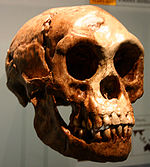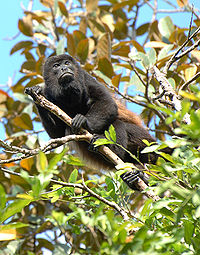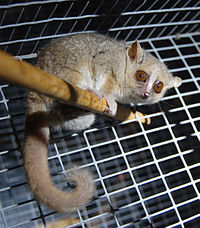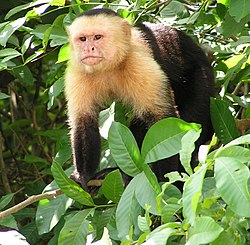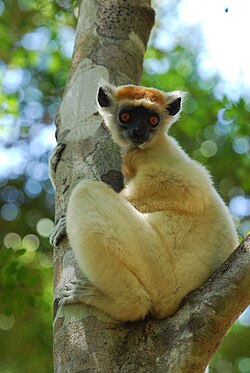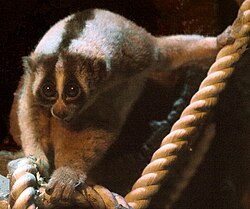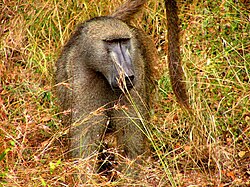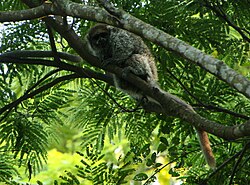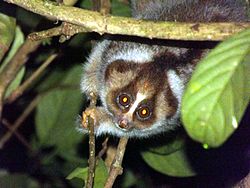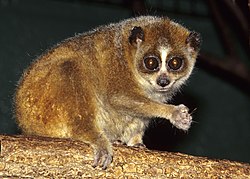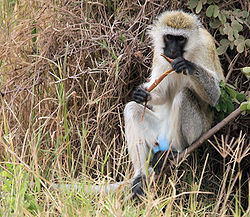Portal:Primates/Selected species
Nominations
Articles of species need to be FA/GAs or B-class of the WikiProject Primates article assessment.
{{Portal:Primates/Selected species/Layout
|image=
|size= 250px
|species_binomial=
|common_name=
|status=
|status_system=
|text=
|link=
}}
Use the lead image of the article excluding File:. The image size is left at 250px by default, but feel free to be bold and change it if necessary. Paste the scientific name in the species binomial parameter and the common name in the common name parameter. If there is no common name, leave it blank. Paste the status (for example, EX for extinct) in the status field and the IUCN system (e.g. iucn3.1) in the status_system parameter (you can find this information in the taxobox of the article). Finally, use a descriptive summary in the text field and provide the link to the article in the link parameter.
Archive
Selected species 1
Portal:Primates/Selected species/1

Near Threatened (IUCN 3.1)|Near Threatened
The ring-tailed lemur (Lemur catta) is a large strepsirhine primate and the most recognized lemur due to its long, black and white ringed tail. Like all lemurs it is endemic to the island of Madagascar. It is omnivorous and the most terrestrial of lemurs. The animal is diurnal, being active exclusively in daylight hours. The ring-tailed lemur is highly social, living in groups of up to 30 individuals. As one of the most vocal primates, the ring-tailed lemur utilizes numerous vocalizations including group cohesion and alarm calls. Despite being listed as Near Threatened by the IUCN Red List and suffering from habitat destruction, the ring-tailed lemur reproduces readily in captivity and is the most populous lemur in zoos worldwide, numbering more than 2000 individuals. It typically lives 16 to 19 years in the wild and 27 years in captivity.
Selected species 2
Portal:Primates/Selected species/2

Extinct (IUCN 3.1)|Extinct
Homo floresiensis ( /flɔːrˈɛziːˌɛn.sɪs/), also known as "Flores Man" or "Hobbit" (after the fictional species), is an extinct species of small archaic humans that inhabited the island of Flores, Indonesia, until the arrival of modern humans about 50,000 years ago.
The remains of an individual who would have stood about 1.1 m (3 ft 7 in) in height were discovered in 2003 at Liang Bua cave. As of 2015, partial skeletons of fifteen individuals have been recovered, including one complete skull, referred to as "LB1". (Full article...)
Selected species 3
Portal:Primates/Selected species/3

Vulnerable (IUCN 3.1)|Vulnerable
The Central American squirrel monkey (Saimiri oerstedii) is a squirrel monkey species from the Pacific coast of Costa Rica and Panama. It is a small monkey with an orange back and a distinctive white and black facial mask. It has an omnivorous diet, eating fruits, other plant materials, invertebrates and some small vertebrates. In turn, it has a number of predators, including raptors, cats and snakes. It lives in large groups that typically contain between 20 and 75 monkeys. It has one of the most egalitarian social structures of all monkeys. Females do not form dominance hierarchies, and males only do so at breeding season. Females become sexually mature at 2½ years, and males at 4 to 5 years. Sexually mature females leave the natal group, but males can remain with their natal group their entire life. The Central American squirrel monkey can live for more than 15 years.
Selected species 4
Portal:Primates/Selected species/4

Least Concern (IUCN 3.1)|Least Concern
The mantled howler (Alouatta palliata), or golden-mantled howling monkey, is a species of howler monkey, a type of New World monkey, from Central and South America. It is one of the monkey species most often seen and heard in the wild in Central America. It takes its "mantled" name from the long guard hairs on its sides. The mantled howler is one of the largest Central American monkeys, and males can weigh up to 9.8 kg (22 lb). It is the one Central American monkey whose diet is composed mostly of leaves. The mantled howler has several adaptations to this folivorous diet. Since leaves are difficult to digest and provide less energy than most foods, mantled howlers spend the majority of each day resting and sleeping. Male mantled howlers also have an enlarged hyoid bone, which is a hollow bone near the vocal cords. This enlarged bone amplifies the calls made by the male, which give the monkey its common name of "howler". Howling allows the monkeys to locate each other without expending energy on moving or risking physical confrontation.
Selected species 5
Portal:Primates/Selected species/5

Least Concern (IUCN 3.1)|Least Concern
The gray mouse lemur (Microcebus murinus) is a small strepsirrhine primate, found only on the island of Madagascar. Weighing 58 to 67 grams (2.0 to 2.4 oz), it is the largest mouse lemur, yet smaller than the world's smallest monkey, the pygmy marmoset, which ranges between 85 and 140 g (3.0 and 4.9 oz). Its genus, Microcebus, includes the smallest primates in the world.
The gray mouse lemur is named for its mouse-like size and coloration. It is known locally (in Malagasy) as tsidy, koitsiky, titlivaha, pondiky, and vakiandri.
Like all mouse lemurs, this species is nocturnal and arboreal. It is very active, and although it forages alone, groups of males and females will form sleeping groups and share tree holes during the day. The gray mouse lemur can be found in several types of forest throughout western and southern Madagascar. Its diet consists primarily of fruit, insects, flowers, and nectar.
Selected species 6
Portal:Primates/Selected species/6

Least Concern (IUCN 3.1)|Least Concern
The white-headed capuchin (Cebus capucinus), also known as the white-faced capuchin or white-throated capuchin, is a medium-sized New World monkey of the family Cebidae, subfamily Cebinae. Native to the forests of Central America and the extreme north-western portion of South America, the white-headed capuchin is important to rainforest ecology for its role in dispersing seeds and pollen. Among the best known monkeys, the white-headed capuchin is recognized as the typical companion to the organ grinder. In recent years the species has become popular in North American media. It is a highly intelligent monkey and has been trained to assist paraplegic persons. It is a medium-sized monkey, weighing up to 3.9 kg (8.6 lb). It is mostly black, but with a pink face and white on much of the front part of the body, giving it its common name. It has a distinctive prehensile tail that is often carried coiled up and is used to help support the monkey when it is feeding beneath a branch.
Selected species 7
Portal:Primates/Selected species/7

Vulnerable (IUCN 3.1)|Vulnerable
The collared brown lemur (Eulemur collaris) is a medium-sized strepsirhine primate and one of twelve species of brown lemur in the Lemuridae family. It is only found in south-eastern Madagascar. Like most species of lemur, it is arboreal, moving quadrupedally and occasionally leaping from tree to tree. Like other brown lemurs, it lives in social groups, primarily eats fruit, is active both day and night, exhibits sexual dichromatism, and does not demonstrate female dominance. The species is listed as Vulnerable by the International Union for Conservation of Nature (IUCN) and is threatened primarily by habitat loss.
Selected species 8
Portal:Primates/Selected species/8

Endangered (IUCN 3.1)|Endangered
Geoffroy's spider monkey (Ateles geoffroyi), also known as the black-handed spider monkey or the Central American spider monkey, is a species of spider monkey, a type of New World monkey, from Central America, parts of Mexico and possibly a small portion of Colombia. There are at least five subspecies. Some primatologists classify the black-headed spider monkey (A. fusciceps), found in Panama, Colombia, and Ecuador as the same species as Geoffroy's spider monkey. (Full article...)
Selected species 9
Portal:Primates/Selected species/9

Endangered (IUCN 3.1)|Endangered
The Zanzibar red colobus (Procolobus kirkii) is a species of red colobus monkey endemic to Unguja, the main island of the Zanzibar archipelago, off the coast of Tanzania. It is also known as Kirk's red colobus after Sir John Kirk (1832-1922), the British Resident of Zanzibar who first brought it to the attention of zoological science. It is now classified as an endangered species and in the mid-1990s was adopted as the flagship species for conservation in Zanzibar. The population trend is still decreasing and because this species is only located in the archipelago, conservationists are attempting to work with local government to devise a proper, effective strategy to protect the population and habitat. The species has been reclassified twice; it was previously in the genus Colobus, and more recently in the genus Procolobus.
Selected species 10
Portal:Primates/Selected species/10

Endangered (IUCN 3.1)|Endangered
The golden-crowned sifaka or Tattersall's sifaka (Propithecus tattersalli) is a medium-sized lemur characterized by mostly white fur, prominent furry ears and a golden-orange crown. It is one of the smallest sifakas (genus Propithecus), weighing around 3.5 kg (7.7 lb) and measuring approximately 90 cm (35 in) from head to tail. Like all sifakas, it is a vertical clinger and leaper, and its diet includes mostly seeds and leaves. The golden-crowned sifaka is named after its discoverer, Ian Tattersall, who first spotted the species in 1974. However, it was not formally described until 1988, after a research team led by Elwyn Simons observed and captured them. The golden-crowned sifaka most closely resembles the western forest sifakas of the P. verreauxi group, yet its karyotype suggests a closer relationship with the P. diadema group of eastern forest sifakas. Despite the similarities with both groups, more recent studies of its karyotype support its classification as a distinct species.
Selected species 11
Portal:Primates/Selected species/11

Critically Endangered (IUCN 3.1)|Critically endangered
The silky sifaka or silky simpona (Propithecus candidus) is a large lemur characterized by long, silky white fur and has a restricted range in northeastern Madagascar. It is one of the rarest mammals on earth, and is listed by the International Union for Conservation of Nature (IUCN) as one of the world's 25 most critically endangered primates. The silky sifaka is one of nine sifaka species (genus Propithecus), and one of four former subspecies of diademed sifaka (P. diadema).
The silky sifaka has a variable social structure, and lives in groups of two to nine individuals. It spends most of its day feeding and resting, though it also devotes a considerable amount of the day to social behaviors, such as playing and grooming, as well as traveling. Females take priority over males during feeding. The diet consists primarily of leaves and seeds and is highly varied, consisting of many plant species. It is a seasonal breeder and only mates one day a year. Parental care is shared among adults in the group, as it is with other sifaka species. Like all lemurs, it relies strongly on scent for communication, often scent-marking trees near the center of its home range, as opposed to the territory borders. The species is only found within a few protected areas in the rainforests of northeastern Madagascar, with the majority of the remaining population in Marojejy National Park and Anjanaharibe-Sud Special Reserve. The silky sifaka is hunted throughout its range as there is no local taboo (fady) against eating this species. Habitat disturbance, such as slash-and-burn agriculture (tavy), illegal logging of precious woods (particularly, rosewood) and fuel-wood, also occurs within the protected areas where it is found.
Selected species 12
Portal:Primates/Selected species/12

Least Concern (IUCN 3.1)|Least Concern
Geoffroy's tamarin (Saguinus geoffroyi), also known as the Panamanian, red-crested or rufous-naped tamarin, is a tamarin, a type of small monkey, found in Panama and Colombia. It is predominantly black and white, with a reddish nape. Diurnal, Geoffroy's tamarin spends most of its time in trees, but does come down to the ground occasionally. It lives in groups that most often number between three and five individuals, and generally include one or more adults of each gender. It eats a variety of foods, including insects, exudates, fruits and other plant parts. Insects and fruits account for the majority of its diet, but exudates are also important. But since its teeth are not adapted for gouging trees to get to the sap, it can only eat exudates when they are easily available. Although a variety of reproductive methods are used, the most common is for a single adult female in the group to be reproductively active and to mate with multiple adult males in the group. After a gestation period of about 145 days, she gives birth to either a single infant or twins. Males contribute significantly to care of the infants. Sexual maturity is reached at about 2 years, and it can live up to 13 years. Geoffroy's tamarin is classified as "Least Concern" by the IUCN.
Selected species 13
Portal:Primates/Selected species/13

Endangered (IUCN 3.1)|Endangered
The Javan slow loris (Nycticebus javanicus) is a strepsirrhine primate and a species of slow loris native to the western and central portions of the island of Java, in Indonesia. For many years, it was considered a subspecies of the Sunda slow loris (N. coucang), until the 2000s when it was promoted to full species status. It is most closely related to the Sunda slow loris and the Bengal slow loris (N. bengalensis). The species has two forms, based on hair length and, to a lesser extent, coloration. Its forehead has a prominent white diamond pattern, which is formed by a distinct stripe that runs over its head and forks towards the eyes and ears. The Javan slow loris weighs between 565–687 g (1.25–1.51 lb) and has a head-body length of about 293 mm (11.5 in). Like all lorises, it is arboreal and moves slowly across vines and lianas instead of jumping from tree to tree. Its diet typically consists of fruit, tree gum, lizards and eggs. It sleeps on exposed branches, sometimes in groups, and is usually seen alone or in pairs.
The Javan slow loris population is in sharp decline due to poaching for the exotic pet trade. It is also used in research associated with traditional medicine. Remaining populations have low densities, and habitat loss is a major threat. For these reasons, the International Union for Conservation of Nature (IUCN) lists its status as "endangered," and it has also been included on the 2008–2010 list of "The World's 25 Most Endangered Primates." It is protected by Indonesian law and, since June 2007, is listed under CITES Appendix I. Despite these protections, as well as its presence in several protected areas, poaching is still incessant and the wildlife protection laws are rarely enforced at the local level.
Selected species 14
Portal:Primates/Selected species/14

Extinct (IUCN 3.1)|Extinct
? Nycticebus linglom is a fossil primate from the Miocene of Thailand. Known only from a single tooth, an upper third molar, it is thought to be related to the living slow lorises (genus Nycticebus), but the material is not sufficient to assign the species to Nycticebus with certainty, and the species name therefore uses open nomenclature. With a width of 1.82 mm, this tooth is very small for a primate. It is triangular in shape, supported by a single root, and shows three main cusps, in addition to various crests. The absence of a fourth cusp, the hypocone, distinguishes it from various other prosimian primates.
Selected species 15
Portal:Primates/Selected species/15

Vulnerable (IUCN 3.1)|Vulnerable
The Bengal slow loris (Nycticebus bengalensis) or northern slow loris is a strepsirrhine primate and a species of slow loris native to the Indian subcontinent and Indochina. Its geographic range is larger than that of any other slow loris species. Considered a subspecies of the Sunda slow loris (N. coucang) until 2001, phylogenetic analysis suggests that the Bengal slow loris is most closely related to the Sunda slow loris. However, some individuals in both species have mitochondrial DNA sequences that resemble those of the other species, due to introgressive hybridization. It is the largest species of slow loris, measuring 26 to 38 cm (10 to 15 in) from head to tail and weighing between 1 and 2.1 kg (2.2 and 4.6 lb). Like other slow lorises, it has a wet nose (rhinarium), a round head, flat face, large eyes, small ears, a vestigial tail, and dense, woolly fur. The toxin it secretes from its brachial gland (a scent gland in its arm) differs chemically from that of other slow loris species and may be used to communicate information about sex, age, health, and social status.
The Bengal slow loris is nocturnal and arboreal, occurring in both evergreen and deciduous forests. Its presence in its native habitat indicates a healthy ecosystem. It is a seed disperser and pollinator, as well as a prey item for carnivores. Its diet primarily consists of fruit, but also includes insects, tree gum, snails, and small vertebrates. In winter, it relies on plant exudates, such as sap and tree gum. The species lives in small family groups, marks its territory with urine, and sleeps during the day by curling up in dense vegetation or in tree holes. It is a seasonal breeder, reproducing once every 12–18 months and usually giving birth to a single offspring. For the first three months, mothers carry their offspring, which reach sexual maturity at around 20 months. The Bengal slow loris can live up to 20 years. The species is listed as "Vulnerable" on the IUCN Red List, and is threatened with extinction due to a growing demand in the exotic pet trade and traditional medicine.
Selected species 16
Portal:Primates/Selected species/16

Vulnerable (IUCN 3.1)|Vulnerable
The Philippine slow loris (Nycticebus menagensis) is a strepsirrhine primate and a species of slow loris that is native to the north and east coastal areas of the island of Borneo, as well as the Sulu Archipelago in the Philippines. The species was first named as the Bornean slow loris in 1892, but lumped into the widespread Sunda slow loris (N. coucang) in 1952. However, it was promoted to full species status – again as the Bornean slow loris – based on molecular analysis in 2006. In 2013, two former subspecies of the Bornean slow loris were elevated to species status, and a new species—N. kayan—was recognized among the Bornean population.
Weighing 265–300 grams (9.3–10.6 oz), it is one of the smallest of the slow lorises, and can be distinguished from other slow lorises by its pale golden to red fur, the lack of markings on its head, and consistent absence of a second upper incisor. Like other slow lorises, it has a vestigial tail, round head, short ears, a curved grooming claw for grooming, and a gland that produces an oily toxin that the animal uses for defense. The Philippine slow loris is arboreal, nocturnal, and occurs in low densities, making it difficult to locate. It is also the least studied of Indonesia's slow lorises. It is found at elevations between 35–100 meters (115–328 ft) in primary and secondary lowland forest, gardens, and plantations. Information about its diet is limited, but it is suspected to be one of the more insectivorous slow loris species, and is also known to eat gum from woody plants. (Full article...)
Selected species 17
Portal:Primates/Selected species/17

Data Deficient (IUCN 3.1)|Data Deficient
The small-toothed sportive lemur (Lepilemur microdon), or small-toothed weasel lemur, is a primate species in the family Lepilemuridae that—like all lemurs—is endemic to Madagascar. The species lives in dense rainforest in southeastern Madagascar, and can be found in Ranomafana National Park and Andringitra National Park. As its name implies, some of its teeth are smaller than those in other sportive lemurs. It is relatively large for a sportive lemur, and is difficult to visually distinguish from the weasel sportive lemur. The species weighs between 0.9 and 1.2 kg (2.0 and 2.6 lb) and measures 55 to 64 cm (22 to 25 in) from head to tail. Its fur is mostly reddish-brown or chestnut color, with a dark stripe running from its head down its back. Its underside and neck are lighter in color. Like other sportive lemurs, it is nocturnal, sleeping in concealed tangles of vegetation as well as tree holes. The small-toothed sportive lemur is solitary and eats leaves, fruits, and flowers. Due to recent taxonomic changes and a lack of clarity about its population size and range, it is listed as "Data Deficient" by the International Union for Conservation of Nature (IUCN). It is also protected from international commercial trade under CITES Appendix I. Its primary threats are habitat loss to slash and burn agriculture and hunting.
Selected species 18
Portal:Primates/Selected species/18

Vulnerable (IUCN 3.1)|Vulnerable
The Sunda slow loris (Nycticebus coucang) or greater slow loris is a strepsirrhine primate and a species of slow loris native to Indonesia, western Malaysia, southern Thailand and Singapore. It measures 27 to 38 cm (11 to 15 in) from head to tail and weighs between 599 and 685 g (21.1 and 24.2 oz). Like other slow lorises, it has a wet nose (rhinarium), a round head, small ears hidden in thick fur, a flat face, large eyes, small ears and a vestigial tail.
The Sunda slow loris is nocturnal and arboreal, typically occurring in evergreen forests. It prefers rainforests with continuous dense canopies and has an extremely low metabolic rate compared to other mammals of its size. Its diet consists of sap, floral nectar, fruit and arthropods. It will feed on exudates such as gum and sap by licking wounds in trees. The species is generally solitary. It has monogamous mating system with the offspring living with the parents. The species is listed as "Vulnerable" on the IUCN Red List. It is threatened with extinction due to a growing demand in the exotic pet trade, and has become one of the most abundant primate species on sale at Indonesian pet markets.
Selected species 19
Portal:Primates/Selected species/19

Critically Endangered (IUCN 3.1)|Critically endangered
Gerp's mouse lemur (Microcebus gerpi) is a species of mouse lemur known only from the Sahafina forest in eastern Madagascar, near Mantadia National Park. Its discovery was announced in 2012 by a German and Malagasy research team. Based on genetic studies, measurements, and photos, the research team confirmed that Gerp's mouse lemur was an undescribed species, distinct from Goodman's mouse lemur, which is found 58 kilometers (36 mi) away. Gerp's mouse lemur is significantly larger, weighing on average 68 grams (2.4 oz), compared to Goodman's mouse lemur, which weighs approximately 44 g (1.6 oz). Jolly's mouse lemur, which is its closest relative and a neighbor to the south, is comparably large, but differs in tail length and genetics. Because it is a recently discovered species, nothing is known about its behavior, communication, ecology, or reproduction. The species appears to be restricted to a small region of lowland evergreen rain forest, and is seriously threatened by forest loss.
Selected species 20
Portal:Primates/Selected species/20

Extinct (IUCN 3.1)|Extinct
Afrasia djijidae is a fossil primate that lived in Myanmar approximately 37 million years ago, during the late middle Eocene. The only species in the genus Afrasia, it was a small primate, estimated to weigh around 100 grams (3.5 oz). Despite the significant geographic distance between them, Afrasia is thought to be closely related to Afrotarsius, an enigmatic fossil found in Libya and Egypt that dates to 38–39 million years ago. If this relationship is correct, it suggests that early simians (a related group or clade consisting of monkeys, apes, and humans) dispersed from Asia to Africa during the middle Eocene and would add further support to the hypothesis that the first simians evolved in Asia, not Africa. Neither Afrasia nor Afrotarsius, which together form the family Afrotarsiidae, is considered ancestral to living simians, but they are part of a side branch or stem group known as eosimiiforms.
Afrasia is known from four isolated molar teeth (shown above) found in the Pondaung Formation of Myanmar. These teeth are similar to those of Afrotarsius and Eosimiidae, and differ only in details of the chewing surface. In the Pondaung Formation, Afrasia was part of a diverse primate community that also includes the eosimiid Bahinia and members of the families Amphipithecidae and Sivaladapidae.
Selected species 21
Portal:Primates/Selected species/21

Least Concern (IUCN 3.1)|Least Concern
The chacma baboon (Papio ursinus), also known as the Cape baboon, is from the Old World monkey family. It is one of the largest of all monkeys. Found primarily in southern Africa, the chacma baboon has a wide variety of social behaviors, including a dominance hierarchy, collective foraging, adoption of young by females, and friendship pairings. These behaviors form parts of a complex evolutionary ecology. In general the species is not threatened, but human population pressure has increased contact between humans and baboons. Hunting, accidents and trapping kill or remove many baboons from the wild. This has reduced baboon numbers and disrupted their social structure.
Selected species 22
Portal:Primates/Selected species/22

Least Concern (IUCN 3.1)|Least Concern
The white-eared titi (Callicebus donacophilus), also known as the Bolivian titi or Bolivian gray titi, is a species of titi, a type of New World monkey, from eastern Bolivia and a small area of Brazil. It is a medium-sized monkey with a grey back, orange underside and distinctive white ear tufts. It has an omnivorous diet, eating fruits, other plant materials and invertebrates. It is predated upon primarily by raptors, though felids and other monkey species have been known to attack the species. It is a monogamous species and lives in small groups of two to seven members consisting of the pair and their offspring. The family group has a home range of 0.005 to 0.14 square kilometres (0.0019 to 0.0541 sq mi) and the adults have a complex vocal repertoire to maintain their territory. It is also known for its characteristic twining of tails when groups are sitting together. White-eared titis can live for more than 25 years in captivity.
The white-eared titi population has a declining trend. The decline is believed to be mainly caused by human-induced habitat loss and degradation. Despite this, the International Union for Conservation of Nature (IUCN) classified the species as Least Concern in 2008 as it has shown adaptability to habitat disturbance and is found over a wide range.
Selected species 23
Portal:Primates/Selected species/23
Nycticebus kayan is a strepsirrhine primate and a species of slow loris that is native to the northern and central highland region of the island of Borneo. The species was originally thought to be a part of the Bornean slow loris (N. menagensis) population until 2013, when a study of museum specimens and photographs identified distinct facial markings, which helped to differentiate it. It is distinguished by the high contrast of its black and white facial features, as well as the shape and width of the stripes of its facial markings.
The species is named after the Kayan River, which runs through its native habitat. As with other slow lorises, this arboreal and nocturnal species primarily eats insects, tree gum, nectar, and fruit and has a toxic bite, a unique feature among primates. Although not yet evaluated by the International Union for Conservation of Nature (IUCN), it is likely to be listed as "Vulnerable" or placed in a higher-risk category when its conservation status is assessed. It is primarily threatened by habitat loss and the illegal wildlife trade.
Selected species 24
Portal:Primates/Selected species/24

Vulnerable (IUCN 3.1)|Vulnerable
The pygmy slow loris (Nycticebus pygmaeus) is a species of slow loris found east of the Mekong River in Vietnam, Laos, eastern Cambodia, and China. It occurs in a variety of forest habitats, including tropical dry forests, semi-evergreen, and evergreen forests. The animal is nocturnal and arboreal, crawling along branches using slow movements in search of prey. It lives together in small groups usually with one or two offspring. An adult can grow to around 19 to 23 cm (7.5 to 9.1 in) long and has a very short tail. It weighs about 450 g (1.0 lb). Its diet consists of fruits, insects, small fauna, tree sap, and floral nectar. The animal has a toxic bite. The pygmy slow loris mates once every 12–18 months and has one or two offspring after an average gestation period of six months. Females reach sexual maturity by 16 months, while males reach maturity by about 18 months. The pygmy slow loris is seasonally fertile during the months of July and August.
The habitat of the pygmy slow loris in Vietnam was greatly reduced due to extensive burning, clearing, and defoliating of forests during the Vietnam War. Extensive hunting for traditional medicines is currently putting severe pressure on Cambodian populations. The pygmy slow loris is seriously threatened by hunting, trade, and habitat destruction; consequently, it is listed in Appendix II of the Convention on International Trade in Endangered Species of Wild Fauna and Flora (CITES), and in 2006 the International Union for Conservation of Nature (IUCN) classified it as "Vulnerable".
Selected species 25
Portal:Primates/Selected species/25

Critically Endangered (IUCN 3.1)|Critically endangered
The cotton-top tamarin (Saguinus oedipus) is a small New World monkey weighing less than 1 lb (0.5 kg). One of the smallest primates, the cotton-top tamarin is easily recognized by the long white sagittal crest extending from its forehead to its shoulders. The species is found in tropical forest edges and secondary forests in northwestern Colombia where it is arboreal and diurnal. Its diet includes insects and plant exudates and it is an important seed disperser in the tropical ecosystem. Groups form a clear dominance hierarchy where only dominant pairs breed. The female normally gives birth to twins and uses pheromones to prevent other females in the group from breeding. These tamarins have been extensively studied for their high level of cooperative care, as well as altruistic and spiteful behaviors. Communication between cotton-top tamarins is sophisticated and shows evidence of grammatical structure, which is acquired.
It is thought that up to 40,000 cotton-top tamarins were caught and exported for use in biomedical research before 1976 when CITES gave them the highest level of protection and all international trade was banned. Now the species is at risk due to large-scale habitat destruction, the lowland forest in northwestern Colombia where the cotton-top tamarin is found has been reduced to five percent of its previous size. It is currently classified as critically endangered and is one of the rarest primates in the world with only 6,000 individuals left in the wild.
Selected species 26
Portal:Primates/Selected species/26

Least Concern (IUCN 3.1)|Least Concern
The mantled guereza (Colobus guereza), also known simply as the guereza, the eastern black-and-white colobus, or the Abyssinian black-and-white colobus, is a black-and-white colobus, a type of Old World monkey. It is native to much of west central and east Africa, including Cameroon, Equatorial Guinea, Nigeria, Ethiopia, Kenya, Tanzania, Uganda and Chad. It has a distinctive appearance which is alluded to in its name; the long white fringes of hair the run along each side of its black trunk are known as a mantle. Its face is framed with white hair and it has a large white tail tuft.
The mantled guereza is diurnal and arboreal, found in both deciduous and evergreen forests. It is an adaptable species that can cope with habitat disturbance and prefers secondary forest close to rivers or lakes. Although previously thought only to eat leaves, it also eats seeds, fruits, and arthropods. It is able to digest plant material with a high fibre content with its specialised stomach and may only eat from a few plant species at a time. It is preyed on by birds of prey and some mammals such as the common chimpanzee and the leopard.
The mantled guereza lives in social groups of three to fifteen individuals. These groups normally include a dominant male, several females, and the offspring of the females. It has a polygynous mating system. The mantled guereza is listed as Least Concern by the International Union for Conservation of Nature (IUCN) because it is widespread and although locally threatened in some areas the decline is not great enough to list it in a higher category of threat. However, one subspecies found in Kenya is listed as Endangered.
Selected species 27
Portal:Primates/Selected species/27

Least Concern (IUCN 3.1)|Least Concern
The vervet monkey (Chlorocebus pygerythrus), or simply vervet, is an Old World monkey of the family Cercopithecidae native to Africa. The term "vervet" is also used to refer to all the members of the genus Chlorocebus. The five distinct subspecies can be found mostly throughout Southern Africa, as well as some of the eastern countries. Vervets were transported to the islands of Barbados, Saint Kitts, and Nevis in conjunction with the African slave trade. These mostly vegetarian monkeys have black faces and grey body hair color, ranging in length from about 19 in (50 cm) for males to about 16 in (40 cm) for females.
In addition to very interesting behavioral research on natural populations, vervet monkeys serve as a nonhuman primate model for understanding genetic and social behaviors of humans. They have been noted for having human-like characteristics, such as hypertension, anxiety, and social and dependent alcohol use. The most significant studies done on vervet monkeys involve their communication and alarm calls, specifically in regard to kin and group recognition and particular predator sightings.
Selected species 50
Portal:Primates/Selected species/50

Near Threatened (IUCN 3.1)|Near Threatened
The Philippine tarsier (Tarsius syrichta), known locally as the maumag in Cebuano/Visayan, is an endangered tarsier species endemic to the Philippines. It is found in the southeastern part of the archipelago, particularly in the islands of Bohol, Samar, Leyte, and Mindanao. Its name is derived from its elongated "tarsus" or ankle bone. Its geographic range also includes Maripipi Island, Siargao Island, Basilan Island and Dinagat Island. Being a member of a family that is about 45 million years old, the Philippine tarsier was only introduced to western biologists in the 18th century.


